For a company whose secondary logo is the word “Software” with a big slash through it, Salesforce.com may have already become the nation’s leading producer of software conferences for businesses. A huge crowd has assembled at the Jacob Javits Center in New York to hear Salesforce CEO Marc Benioff deliver one of his already-legendary keynote speeches. The theme is expected to be another extension of his “delivering on the social enterprise” motif.
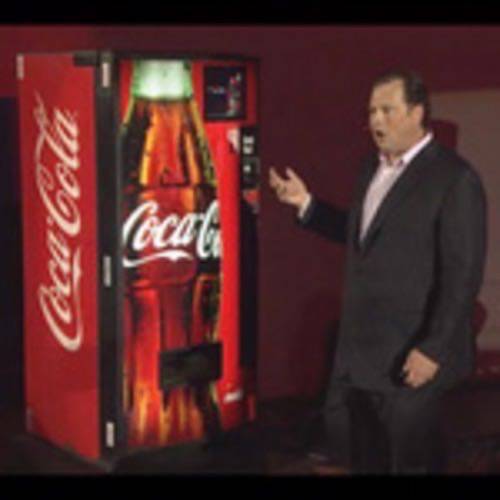
In recent months, Salesforce has been making inroads in building a business software ecosystem around its Chatter system of communication, developing and enabling the development of tools that could potentially wedge Outlook and SharePoint out of the enterprise. Expect a stronger message on the subject of reducing and/or eliminating middleware and message queues, a topic that Salesforce marketing has been chattering about in recent days. ReadWriteWeb is delivering a running summary of Benioff’s speech as it happens.
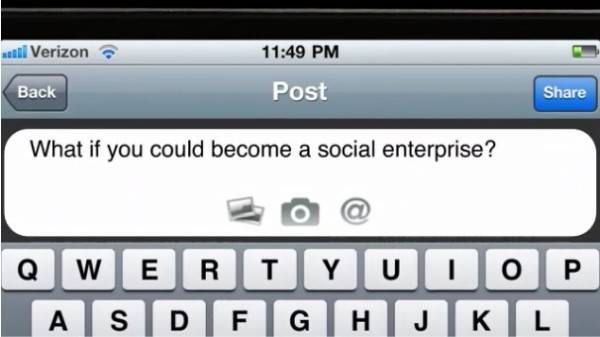
10:18 am ET: Marc Benioff takes the stage. “We’ve been born cloud at Salesforce.com, but we’ve been reborn social.”
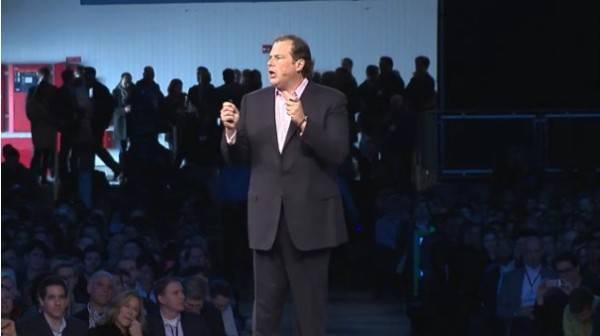
Plans to exceed $3 B in revenue this year, Forbes ranking Salesforce as #1 Most Innovative Company.
Starting by recognizing the contributions of non-profit organizations. Not always as blessed with the technical resources that commercial customers have.
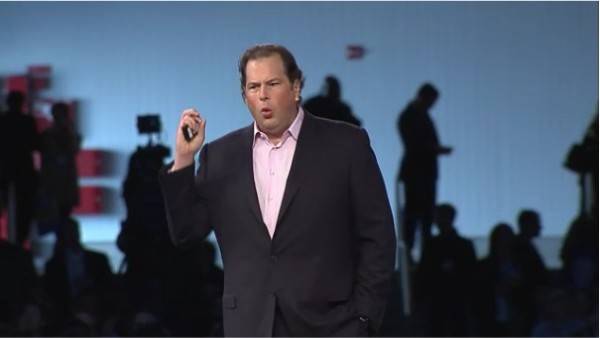
“I want to tell you what it is about my job that I love so much,” he goes on, stepping outside of the spotlight and into the aisle as he’s been known to do. Listing all the great technological leaps forward, as he’s done before, paying tribute to Steve Jobs for bringing forth the mobile revolution. “But the new era that we’re in is the social revolution. And just like every other cycle before it, it’s bigger and more exciting than ever before.”
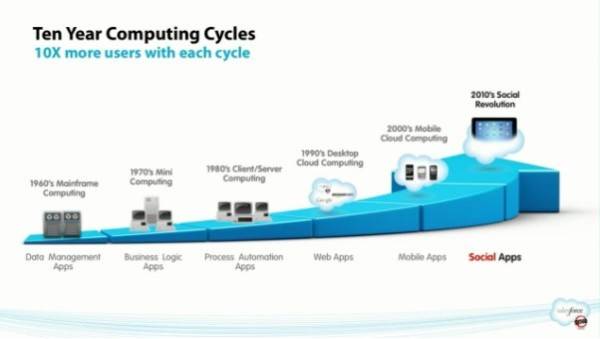
Repeating the message of the political revolutions in the Middle East, which once again Benioff credits to Facebook. Credits the Occupy movement to the proliferation of an online display ad:
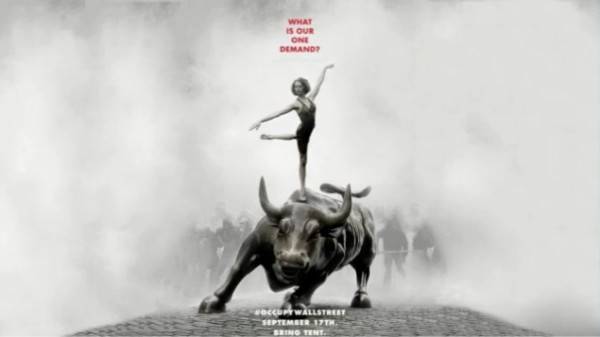
“A 22-year-old nanny brought down the Bank of America! Isn’t that amazing?”
10:29 am ET: The Arab Spring, he says, will lead to the Social Spring, the CEO Spring, the Corporate Spring. “Great success, but how do we do it? What do we do? What is causing this? What is causing this? What is causing this?”
Facebook is eating the Web, he says. He cites this graph:
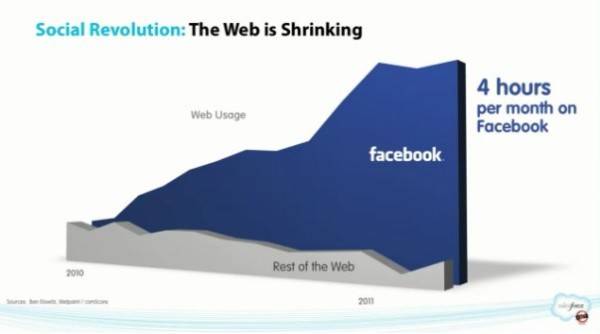
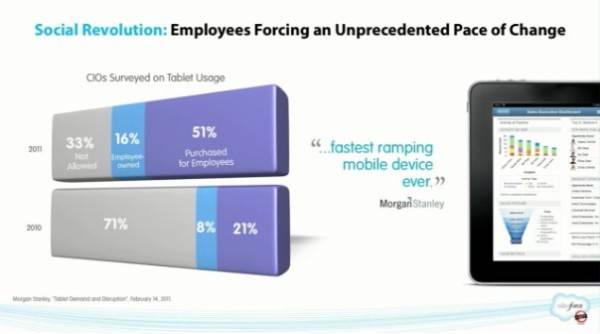
If individuals coordinating the placement of tents in the park in Oakland can use social tools to decide where to go, then business can and should use the same tools. It’s also “leaderless” – there’s not necessarily someone in charge, and the CEO suggests that’s a good thing.
“Not everybody is on the social revolution. Not everyone is on board. But our employees are in it, our customers are in it. They’re accelerating what products are successful. But it’s a social divide! It’s a social divide! What about our products? How do we cross the gap of business performance? How do our enterprises bridge this social divide?”
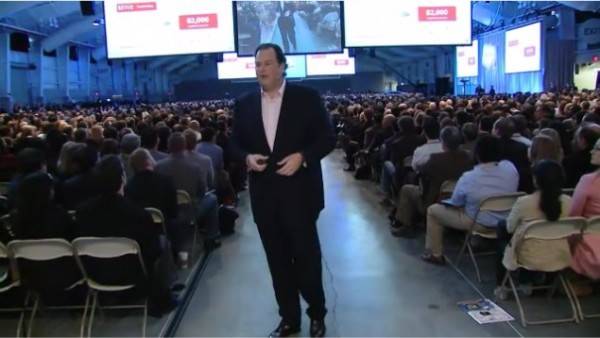
Introducing a three-step process. Business social networks, then customer social networks, then product social networks. “The core of the social enterprise is the cloud. It’s fast, it’s easy, it’s open.” Lowest cost of the transaction per carbon in the world.
“But beware of the false cloud,” Benioff adds. New, proprietary mainframes are the false cloud. “We’ve got the cloud! And we can install it in your data center tomorrow,” he says mockingly. “If it’s about more hardware, it’s not about the cloud! If it’s about another software update, it’s not about the cloud!”
10:40 am ET: Plays the Burberry video seen at Dreamforce a few months back. Introduces Angela Ahrendts, Burberry CEO.
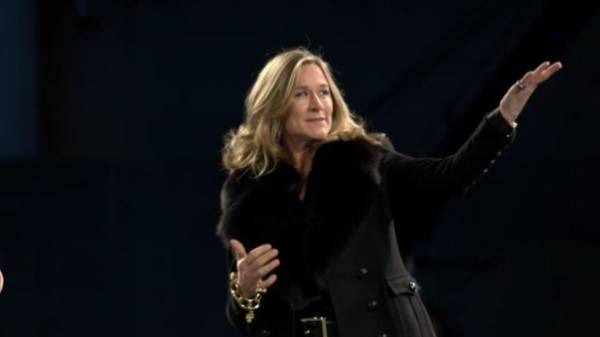
Multiple constituencies come into Burberry every day through the front door, but back end infrastructure needs to be able to connect those constituencies with the people they need to speak with. “Our vision was Facebook for Burberry… We have to change our language to communicate the way they’re used to.”
Benioff mentions that SAP provides the back office infrastructure for Burberry.
“For a retail company, usually it’s about the store. But that’s the store,” says Ahrendts, indicating the projection of the Burberry front page. She explains why the online store must represent the full retail store, giving the customer the feeling of “walking in.” “Every screen has the ability to move and interact in the way you’d have human interaction in a store.” Can customize that response via country. But previously, was not able to deal directly with suppliers with the same ease that it deals with customers. Done through the integration of Salesforce Chatter with Burberry World, which links back with the SAP infrastructure. “So this is the front door now.”
[Interesting how this front door takes place on the Web, which is the same technology Benioff said 15 minutes earlier was being eaten by Facebook. How would a customer feel like she’s in Burberry World, if that front end were being supplied by Facebook?]10:49 am ET: So what is the first step? “Create that customer social profile.” Then create the employee social profile, and then the product social profile. [A three-step first step.]
Benioff tells the story of visiting customers in Detroit [same story told during Dreamforce]. Going to a hotel that gets great Yelp ratings. “This amazing thing happens. We got to the hotel, and the guy at the front desk says, ‘Mr. Benioff, we’re so happy that you’re here! Our CEO FedExed a note to you overnight saying, thank you for coming. And that restaurant you talked about on Twitter? We got you reservations, you’re all set!'” Uh-huh. “That’s not what happened.”
What really happened, of course, is that he was handed the key, he grabbed his bags, he went upstairs, and he went into an empty room with the lights off. “How can this be?? Is this company not even aware of the technology available to them to create a great customer experience? A customer social profile is so good for business. Delighting customers is knowing who they are and what they like.”
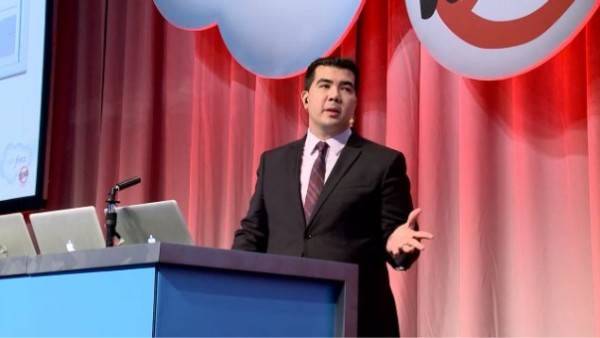
10:54 am ET: Noting changes to customer contacts screen in Salesforce. Dan Darcy, VP product marketing, showing how new contacts screen shows what the customer has been saying on Facebook, LinkedIn, and Twitter.
Benioff mentions Data Residency option, so that some business data does not have to be shared with Salesforce data center or with Database.com.
Databases have been too proprietary, too expensive, too difficult to use. Tells the story of being at the GE Management Center, where Salesforce gives a special demo for Jeffrey Immelt (GE CEO). Showed integration of existing GE database with Database.com. “Would you stay this is step one, get your data model together?” asks the CEO. [The fourth “step one” of the day.]
Salesforce can build a custom version of the presentation for specific corporate customers.
“So if that’s step one, what’s step two?” Employee social network. “Why do I know more about my employees and my customers on Facebook, than I do my own family? How can we take that power, and turn it back on the company?” [This keynote fits the Dreamforce template so perfectly that any moment now, I expect Benioff to find a Coke machine.]
NBC Universal story, also a video shown last time. Story of implementing collaboration backbone, 300% ROI in the first week.
11:02 am ET: Chatter only released in 2010, so much has happened in only three conferences. Introducing PayPal founder Max Levchin.
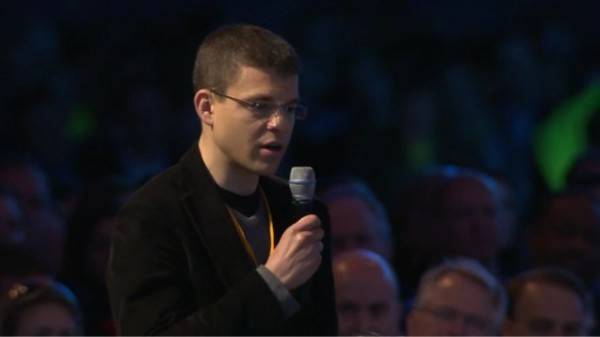
Believe it or not, Levchin critiques Benioff for having asked a complex and long question. “I had 15 seconds of prep time right there to come up with an answer.” [Just who is the guest of whom here?]
Levchin says that companies are failing to mine the tremendous amount of data they’re generating. He criticizes businesses for not realizing that cloud isn’t just about not having to upgrade their servers any more. [Something tells me Levchin won’t be back in six months, but Ahrends will.]
11:09 am ET: With NBC Universal, Benioff says, he gets the picture in his mind of Customer 360.
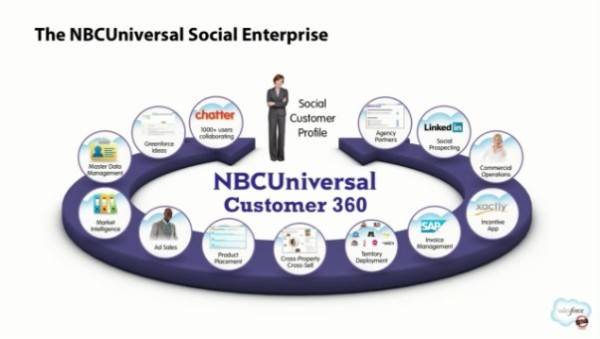
“But we can go farther. We can go So. Much. Farther.” Tells story of an investment banker who tells him about all these companies he wants the CEO to look at. “Have you had an e-mail of four or five or ten PDFs of analysts’ reports? That’s not how I want to communicate. I certainly don’t want to manage those files, and I don’t want to download them. I want to keep them all in the cloud.” Moving beyond to customer and supplier social networks.
11:12 am ET: Chief Marketing Officer Kraig Swensrud takes the stage. “Chatter looks and feels like Facebook, but it’s private and secure for your company.” Teams working together to service a customer better. “The flattening of an organization.” Executives asking questions and getting responses and ideas back in real-time. “This is becoming the new UI of the entire Salesforce application.” Can drill down into any object in the system. Can see which apps a customer has installed from the Facebook and iTunes app stores.
“Social networking is different. The answers actually find you.” Chatter Now allows real-time presence and IM inside the company, for live chat. File-sharing with hyperlinks to the underlying file system, no downloads necessary. Chatter Customer Groups for real-time customer intelligence. Customers do not have access to private information, but instead only the information you delegate to a group. Bringing a customer into a group is as simple as sending an invitation, customer gets direct access to documents. One-click log-in from e-mail to Salesforce customer screen.
Chatter Mobile already in use for providing such screens on mobile devices in app style – first demoed with iPad, then with Android Honeycomb-based tablet.
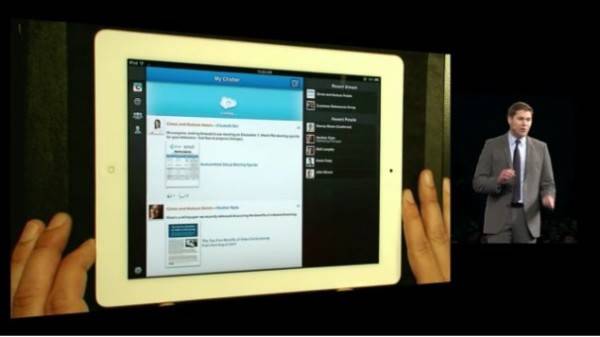
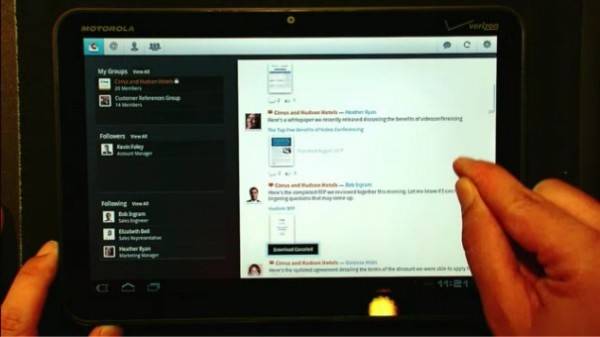
11:21 am ET: “But what’s the second thing that’s important?” asks Benioff. [The second #2 of the day.] “It’s about selling.” How do we bring the sales cloud in with data. Customers say they want to “clean” these fields or fill these fields in? Data.com takes contacts page, adds a Data button, gives employees access to “the best data possible.”
Video of Napa Valley winery Bespoke using Data.com.
11:27 am ET: The rebuilding of software for the tablet platform. Next generation of software is emerging around HTML5. “You have all the power of the cloud services, and the security and integrity of the cloud services, but you continue to have the fundamental persistence of cloud computing.” Touch.salesforce.com Salesforce UI around Salesforce.com.
First peek of pictures of Salesforce.com on tablets, HTML5. Brings Kraig back out. Throws in the fact that analytics are now part of Chatter stream (actually completing the part of his Chatter demo that got cut off in the previous half-hour, not actually premiering Touch quite yet.) Private and secure social collaboration space inside of the sales app. Can get pricing and discounting approved by sales manager, inside the Chatter stream.
Now moving to the Touch part of the demo. On the iPad, Chatter page (which users already know) is accented with a functions bar along the top.
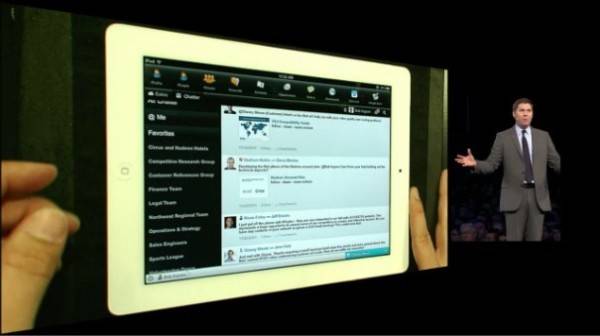
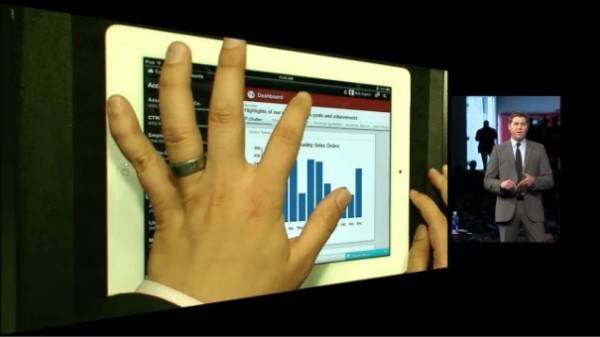
Customization screens built into existing Salesforce will be automatically rendered on Touch screen.
Demonstrates how Data button may be used to fill in existing information from the cloud, into areas and fields that need to be filled.
11:38 am ET: Benioff: “For me, it’s about the customers.” Introduces Sigal Zarmi, CIO of GE Capital. “We’re not just bankers, we’re builders,” she says. Started a social footprint project called GE Edge, to bring CFOs and CEOs of big companies together to exchange information, share knowledge, “and also tap into GE expertise.” GE brought the idea to Salesforce, which built it on its own platform. Also enables customer collaboration channel.
Built in 5 weeks in collaboration with Salesforce.com, hosted by Ohio State University.
11:42 am ET: Benioff: “Service and engagement is something that has dramatically shifted over the last 12 months.” If you go to Bank of America help, you’ll find its call centers can respond via Twitter. KLM Airlines has similar customer service capability tied in with Twitter. KLM video. Reminder that private data always remains protected.
“The entire enterprise is being transformed. It’s reaching through every application, every way we touch the customer,” says Benioff. Brings Kraig back on stage.
Demonstrates service cloud app. Importance of social media started on Twitter. Everything Twitter users posted, including gripes, was public. Customers tend to share their gripes on Twitter, and then YouTube.
Questions may be routed within a company specifically to the folks with expertise. Cases may be escalated, service agent may bring five or more people into the conversation, perhaps including engineer, sales rep. Chatter Answers are now part of the service cloud. Customers can type questions into a box, system can recommend other customers with similar problems, bringing together customers to help one another.
On the agent’s side, shows the customer, history of customer, previous cases. Call center agent typically asks drill-down questions. Those questions can be supplied via scripting that reads the nature of the customer’s questions. Can connect directly with Facetime on iPhone.
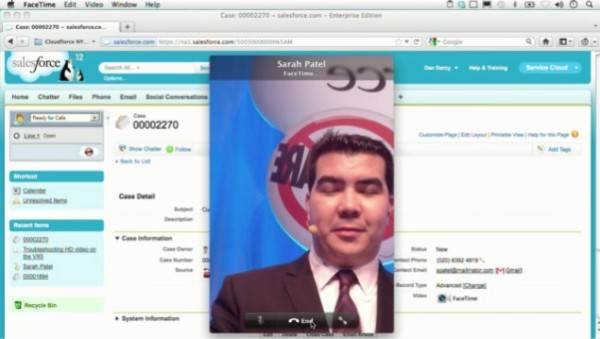
11:55 am ET: Back to Benioff: Deep inside the social enterprise, how do we build custom apps to run the business? “How do we automate-extend our enterprise?” 4GLs are broken. Introduces Rich Lu of Facebook for automating the back office, talking about how Force.com can be customized for filling gaps in the system, adapting existing apps, “using Salesforce as the glue.”
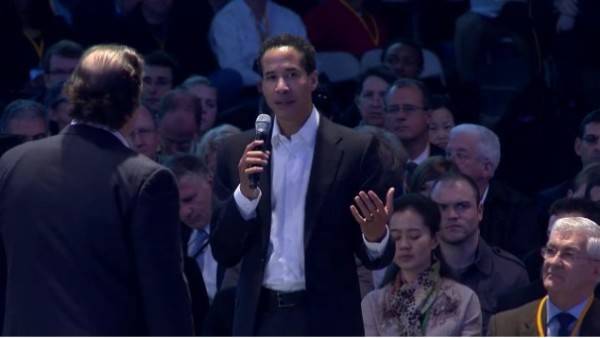
Next introduces Chuck Phillips, CEO of Infor, former president of Oracle. Calls Infor “the third largest applications company in the world.” Creating software for hospitality providers that enables a hotel chain to build social profiles around its customers, knowing their likes, dislikes, and preferences from visit to visit.
Infor had the advantage, he says, of a hybrid business model which enabled it to be in the cloud from the beginning. But has learned from its own transitions how to lead customers into the cloud.
12:01 pm ET: Benioff introduces Siteforce, ability to drag-and-drop components of social features into a custom app. (Doesn’t use the term “mashup,” thankfully.)
Millions of apps already on Salesforce AppExchange. Announcing AppExchange mobile.
First mention of Heroku, where customers can build complete applications. Quick mention of Disney.
Video from ASICS, which built “Support Your Marathoner” – a way for families to send words of encouragement to their favorite runners.
Keynote has definitely gone into fast-forward mode to get subject points finished. “We see marketing itself transforming. Marketing is the ability to really listen to customers.” Social marketing technology around Radian6, with social engagements and social hubs. Mention of Gatorade social media command center, which was the subject of a video at Dreamforce. Reintroduces Kraig.
Radian6 can pull back every conversation that’s had on social media about a subject, including about TD Ameritrade.
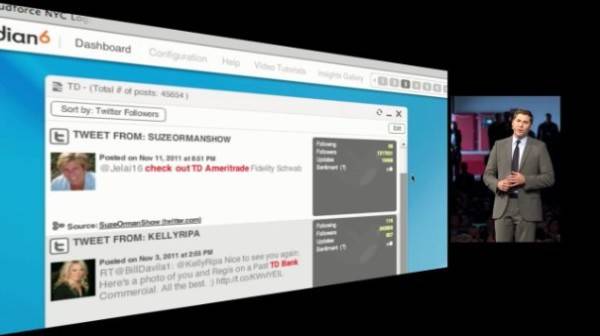
Can drill down into the classes of customers who are talking right now about a product. So much for needing to convene focus groups. “Social hub” technology can define automated rules for how cases are handled within an organization. So all the conversations about a product that meet specific criteria, such as needing a response, can be routed to campaign managers within an organization who can provide offers. Drill-down into customer social profile can show where she is and what she’s doing (she’s at the bank, she’s applying for a mortgage right now, can communicate offers right now). Can present offers back to the customer through iPhone or other mobile device.
12:13 pm ET Benioff now walking around the Toyota. Bracelet he’s wearing is recording his every activity. “It’s a product social network. Products need to become much more social.”
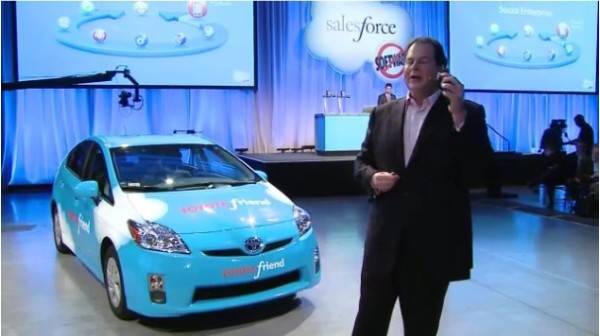
“I want my car to be my friend… I want a Toyota friend,” he says. You need to know if the car’s charged, if it’s ready to go, if the tire is low. “It’s a community, it’s not just a car. It’s a community of dealers, the factory, the cars.” Video from CEO of Toyota, who thanks Benioff personally for changing his life with the idea of the Toyota Friend service.
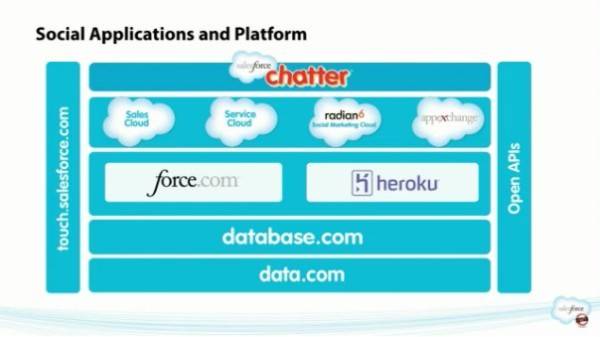
12:19 pm ET: “There is a new world and a new opportunity that is unfolding for all of us,” says Benioff. Rebuilt everything around the vision of going to a higher place. Moved away from per-user pricing, now every product for every employee at one price.





















